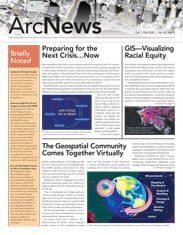On March 9, 2020, the public became aware of Ohio’s first three confirmed cases of coronavirus disease 2019 (COVID-19), and not two weeks later, the state recorded its first death from the virus. That set off a chain of events that quickly changed how society in Ohio—let alone the rest of the world—functions, and it altered the way I would lead as manager of Cuyahoga County, Ohio’s GIS department.
On March 13, the county ordered all equipped, nonessential employees to work from home. Nonessential county employees without proper equipment were permitted to take up to two weeks of paid leave starting March 16. On March 18, the Cuyahoga County executive ordered all county buildings closed to the public. And on March 22, following the lead of several other states, Ohio governor Mike DeWine issued a statewide stay-at-home order.
As a leader, I knew I needed to communicate to my staff how fluid the situation was and that I empathized with their feelings of uncertainty. I gave them reassurance that we would get through this together. And then I had to quickly adapt to managing a team of GIS professionals working from home, spread across northeastern Ohio.
Many companies and organizations had not prepared for business continuity in the event of a pandemic. Many did not have plans for decentralizing staff to stop the spread of a highly contagious virus. The new work-from-home reality was a culture shift. It took some getting used to and trial and error. The added stress of living through a global pandemic and the uncertainty of what each new day would bring did not make this transition any easier. So at Cuyahoga County, we took it one day at a time, made incremental progress, and have so far gotten through it and even begun to thrive in this new paradigm.

To ensure a successful transition to working from home, I made sure that my staff had the hardware, software, and equipment they needed to be effective. I coordinated with my IT department to obtain a computer system and virtual private network (VPN) connection for each of my team members so we could access our GIS licensing, infrastructure, and data. I also made sure everyone on the team had credentials and could work within the security parameters set forth by the county’s chief security officer.
I then set out to establish effective rules for communicating. In a typical office environment, I got to see my employees every day. I was able to check in with them to see how their weekends went, if they needed my assistance, and how they were progressing on work assignments. Communication in the office was personal and seamless. But working in different locations? That did not afford them nor me that comfort, so we had to come up with a communication plan. What platforms were we going to use? What expectations would we have for communication? How frequently were we going to meet?
For our instant communication needs, we decided to use our Slack account. To stay organized, we set up specific channels for segmenting our communication by topic. Channels proved extremely helpful when the whole team attended the 2020 Esri User Conference. Slack allowed us to have one-on-one chat channels for personal communication, too. Setting up a video conferencing platform was not as straightforward, however. In the beginning, we only had Cisco Webex, so we used that. As time went on, we gained access to Microsoft Teams, Zoom, and Slack video conferencing. We have test-driven each video app, but none of them meet all our needs, so we remain flexible while using Teams for most of our meetings.
In evaluating what everyone’s expectations were for communication, I knew that I did not want to micromanage my staff. We have built trust working together in the office, and I always want to empower my team members to act professionally. I understand that, when working from home, staff need flexibility to walk the dog, greet the plumber, or care for children. All I expect is that everyone knows each team member’s schedule and availability. We post our schedules in our Time and Attendance channel on Slack, and we keep notes of our hours and work completed.
In terms of meeting frequency, I felt that having predictable video conferences would help my employees feel like they were still part of a team and working toward a shared vision. We continued to hold a staff meeting and a strategic planning session once a week. We also introduced Breakfast with CEGIS (Cuyahoga Enterprise GIS), a two-hour meeting that takes place once a week wherein a team member educates the rest of the group on county GIS processes, procedures, or best practices. By sharing knowledge like this, we are no longer dependent on one person in a crisis; we have more business continuity.
Once I made sure everyone had the tools they needed to work from home and we had a communication plan in place, I followed five basic principles to manage my team effectively.
- Encourage setting parameters, such as a dedicated work space, and seeking work-life balance. I have a desk in my basement, where I set up my workstation. I now call this my office. My wife and two sons know that when I am in the basement, I am at work. I recommend establishing a dedicated space for work only—even if it is a desk in the corner of the living room or bedroom. This helps separate work life from home life, which, I have found, is the key to finding clarity of purpose while working from home.
- Have 360 degrees of accountability. Understanding what everyone is working on and setting goals and deadlines helps my team be productive and stay on task. Just because I cannot see my team members doing the work does not mean they are not being productive. One of the special things about working in GIS is that it allows us to see progress in many ways, whether it is in data maintenance or the steady creation of a map or app. I trust my team’s professionalism, which is essential for accountability.
- Invite flexible work schedules. For my team, work hours are normally between 7:00 a.m. and 6:00 p.m., Monday through Friday. But working from home has changed that. It has allowed my team to experiment with nontypical schedules, such as working four 10-hour days in a week or trying out four 9-hour days with a half-day Friday. This works because my team members and I communicate our plans with each other, especially any variations in our schedules.
- Listen to team members and open sincere lines of communication. Feeling socially isolated is legitimate when working from home. So when I talk to my staff, I check on their well-being. I need to know that they are having human contact, whether virtually or in person, while following social distancing regulations. My team also finds time to chat about non-work-related issues on Slack, and I often welcome tangents during video calls to add a sense of normalcy to work. As a manager, I also make myself available for one-on-one conversations, which is key to team building.
- Celebrate successes. Giving credit where credit is due is important. My team members deserve a tremendous amount of approbation for their flexibility and adaptability in transitioning from a traditional and institutional office environment to working from home. During these uncertain times, they have stayed positive and kept pressing forward. Without great employees, I would not have a highly successful GIS department. In this spirit, I would like to recognize senior analyst Dan Giersz, GIS analyst Jordan Abbott, GIS analyst Joe Milan, GIS technician Matt McGuire, and GIS technician Justin Haynes for continuing to provide excellent service to the residents of Cuyahoga County during this unprecedented time.



